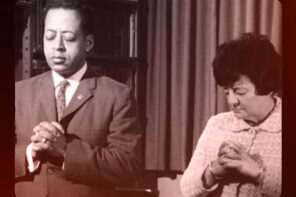’Tis the season to be jolly? Well, not if you attended the annual American Academy of Religion-Society of Biblical Literature (AAR-SBL) national meeting in Chicago last month.
If the experience of others was like mine, those of us with some years on the scene came away deeply dissatisfied. It wasn’t just the anxiety of those in the cattle call for the meat…er…job market. No, nor the ever larger, anonymous mob all packed into the neo-Brutalist McCormick Place convention center. (Overheard: “If Dante’s inferno had had an aircraft hangar, it would have been the McCormick.”)
Setting annual meetings in these massive centers, plus the cumulative effect of well-intentioned policies for promoting young academics, have effectively sabotaged the intergenerational culture essential for a rich sense of intellectual identity.
Yes, I realize that annual meetings hosting thousands of participants need large facilities. Yes, the annual meetings need to offer junior faculty and graduate students opportunities to see and be seen on a national stage. Yes, adding another line to the vita in an ever more competitive market place must be a top priority for job-seekers and the upwardly mobile. And, yes, I also accept that the days when the ‘old bulls’ dominated the agendas are well, and blessedly, past. But, for whatever reason, the combination of convention centers and policies preferring junior faculty has conspired to produce a bad result.
The obvious grumblings about impersonal convention centers needn’t be rehearsed. Instead, I want to drill down a little deeper into key details. First, where can I sit down? Outside the meeting rooms, couches or chairs, much less comfortable ones, do not exist. Convention centers should stop it already with the “War on Sitting Down.” (It makes me think that higher-ups think conventioneers are closeted homeless just checking out the couch or comfy chair scene to bed down for the night. We’re not. We only want to sit and chat with each other.)
Second, even if a couch or comfy chair magically appeared, what space would it occupy? Lobbies don’t exist in convention centers. Hotels lavish wasteful public spaces—“lobbies”—for people to sit and talk; convention centers don’t. There are simply no places carved out for informal sitting and talking in the vast, vacant corridors of these complexes, better suited for massing extras for a sci-fi battle scene.
Convention centers excel at funneling vast hordes of corporate factotums into even vaster hangar-like halls, half-expecting that Apple sprinter woman to charge down the main aisle and smash Big Blue’s telescreen. They militate against the informal socializing that feeds intellectual life.
Third, Convention-Center-World has yet to learn that the 18th amendment was repealed in 1933. Zoning laws, eliminating alcohol consumption on city property, of course, gives CC-world an out. But, this doesn’t change the fact that CC-world refuses to recognize the fact that scholars love to socialize over liquor. We have ever done so, since scholars began toasting and tippling to “Gaudeamus Igitur.” And, unless readers should think I’m an inveterate alcoholic, let me add that coffee or tea bars might just do.
Because of the physical restraints they impose, CCs, like the McCormick, have conspired to stifle the informal gatherings that have always been one of the better reasons for attending the big meetings. Hotel bars and lobbies were great equalizers of rank and status, but also where experience and accomplishment had their part to play. In fact, they were “salons.” They formed institutional memory. They made us all part of a longer conversation that reached from the very young to the very old.
New Ageism?
And, the mention of “the old” brings me to my last point. The present protocols of the AAR-SBL annual national academic meeting seem to have slid decidedly, although perhaps unintentionally, toward a new ageism. In the new ageism, the young take preference over the old.
Yes, annual national meetings should serve the needs of the young to establish themselves in the profession. But, it seems to me that things have gone out of balance when plenary sessions are dominated by fresh, but relatively undistinguished, faces. Things have got out of balance, as well, when senior faculty tend to avoid the annual meeting, neither offering papers nor being the focus of critical assessments of a life’s work.
My sense is that senior faculty may not really be welcome at the annual meeting. This is a great waste. Notice I do not say that senior faculty “know” better than the young. In fact, I would argue that a strong reason for including intergenerational conversation is so that senior faculty can convey what it was like to be wrong!
Over a lifetime, serious scholars change their minds. But, with today’s obsession with the latest and greatest theory, little thought is given to how minds and theories change. We fall madly in love with one “Prince Charming of Theories” today, only to dump him tomorrow for the next, never realizing, in our promiscuous frenzy, how flighty our infatuated shifts of affection show us up to be. Creating intergenerational discourse would help us gain perspective on the longue durée of the intellectual life.
But, this means that however readers may agree with me about the failings of annual meetings held in the aircraft hangars of Dante’s inferno, fixing the annual meeting demands readjusting our policies to insure a rich and vital intergenerational discourse.




